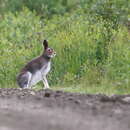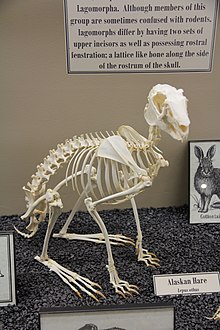fi
nimet breadcrumb-navigoinnissa


Lepus othus is quite similar to L. arcticus and L. timidus. Molecular data suggest these three are conspecific, while morphological data separate them. All are found in different geographic regions.
Perception Channels: tactile ; chemical
Lepus othus is described in "Mammal Species of the World" as rare and decreasing in range and numbers. However, none of the major conservation organizations list them among endangered or threatened species.
US Federal List: no special status
CITES: no special status
IUCN Red List of Threatened Species: least concern
As herbivores, Alaskan hares could cause damage to gardens, but this does not seem to be much of a problem among Arctic people.
Although Alaskan hares are seldom used as a food source for humans, the meat is said to be quite tasty and Arctic people will eat them when necessary. They are more commonly trapped for fur, used to make lining for shoes and robes. They are also a popular sport hunting species.
Positive Impacts: food ; body parts are source of valuable material
Alaskan hares mainly eat woody vegetation, including willow leaves, shoots, bark, and roots. They also feed on grasses, berries, and flowers when they are available. Evenings are the most common time to feed.
Plant Foods: leaves; roots and tubers; wood, bark, or stems; fruit; flowers
Primary Diet: herbivore (Folivore , Lignivore)
Lepus othus is found in northern and western Alaska. Some descriptions also place them at the extreme eastern tip of Siberia.
Biogeographic Regions: nearctic (Native )
Lepus othus tend to live on rocky slopes or upland tundra. They dislike low places. They may also be found in brushy areas that are good for camouflage.
Terrestrial Biomes: tundra
Alaskan hares are the largest hare species in North America, measuring in length from 0.5 to 0.7 m with a tail length of about 8 cm, and very large hind feet (almost 20 cm long) which aid in movement over snow. There is no sexual dimorphism in size. Alaskan hares have robust skulls, strongly recurved upper incisors, and stout claws for digging in the snow. Unlike most hares, they have fairly short ears to conserve heat in the arctic environment. Lepus othus has a gray-brown topcoat with a white undercoat in the summer, but sheds and grows an entirely white coat in the winter, except for the black fur at the tip of the ears which is present year-round.
Range mass: 3.9 to 7.2 kg.
Average mass: 4.8 kg.
Other Physical Features: endothermic ; homoiothermic; bilateral symmetry
Sexual Dimorphism: sexes alike
Alaskan hares are not aggressive animals, they defend themselves mostly through hiding, aided by protective coloration. Still, they have been reported to defend themselves from attacking owls with their strong front legs. Raptors, weasels, wolverines, foxes, and polar bears are all potential predators of Alaskan hares.
Anti-predator Adaptations: cryptic
Lepus othus, in contrast to many other hares, has only one litter per year. This litter tends to be larger on average than other hare species. Litters consist of 4 to 8 (averaging 5) young called leverets. The mating season lasts from April to May and young are born in the summer months, from June to July. They have a somewhat darker pelage than adults. Like all hares, they are born with a full coat of fur and their eyes open. Leverets are fairly active soon after birth. This is useful because they do not live in burrows, but are born in open nest sites above ground.
Range number of offspring: 4 to 8.
Average number of offspring: 5.
Key Reproductive Features: gonochoric/gonochoristic/dioecious (sexes separate); sexual
Parental Investment: precocial

The Alaskan hare (Lepus othus), also known as the tundra hare, is a species of mammal in the family Leporidae.[2] They do not dig burrows and are found in the open tundra of western Alaska and the Alaska Peninsula in the United States. They are solitary for most of the year except during mating season, when they produce a single litter of up to eight young. Predators include birds of prey and polar bears, as well as humans (typically for food).
The Alaskan hare is one of the largest species of hares.[3] The Alaskan hare is sometimes referred to as the tundra hare.[4] They are one of two species of hares native to the state of Alaska in the United States, the other being the more common snowshoe hare.[4] Both male and female adults of Lepus othus normally measure between 50–70 centimetres (20–28 in) in length, with the tail measuring up to an additional 8 centimetres (3.1 in). Their hind feet are 20 centimetres (7.9 in) long, which is thought to allow them to move easily in snowy conditions. It has been reported that they also use their feet for defense against predators. This species weighs from 2.9 to 7.2 kg (6.4 to 15.9 lb), averaging 4.8 kg (11 lb), and it is thus one of the largest lagomorphs, alongside the similarly sized brown hare, Arctic hare and desert hare.[5] The Alaskan hare's ears are fairly short compared to most.[3] They have evolved shorter ears than most hares in order to conserve heat throughout the winter months. Hare's ears play an important role in thermoregulation, and with the Alaskan hare's ears being small, it prevents heat loss in cold climates. In the summer, Alaskan hares have a brown fur coat with white under parts. In the winter, they have a white fur coat with black-tipped ears.[3] They also shed their gray-brown summer topcoat, becoming all white during the winter.[5]
The Alaskan hare is mostly solitary, and usually only congregate in groups during mating season in April and May.[5] They will normally have one litter per year of between four and eight leverets, with the young born during June and July. The leverets are active shortly after birth, and are born with full coats and open eyes.[5][3] Hares can also carry Tularemia which is a bacterial disease that can be transmitted to pets and humans. It can cause infectious wounds, swollen lymph nodes, and fever or symptoms that feel as if you have the flu.[6]
The closest relatives of the Alaskan hare are the Arctic hare, Lepus arcticus, of northern Canada and Greenland, and the mountain hare, Lepus timidus, of northern Eurasia,[2] from which the Alaskan hare is geographically isolated.[1]
They do not live in burrows, but instead nest in open sites. They are most commonly found in upland tundra or in rocky or brushy areas which provide camouflage and protection from predators.[5] Their range includes western and southwestern Alaska, including the Alaska Peninsula.[1][4] They are herbivores, eating a variety of foliage and fruits, with foraging taking place primarily at dawn and dusk.[5] Alaskan hares also feed on green plants in the summer, and bark and twigs in the winter.[3] Predators include foxes, polar bears, wolverines, weasels, and birds of prey.[5] They are taken opportunistically by humans for food or for their fur.[7] Their fur can be and is used to line shoes and robes in Alaska.[3]
 Alaskan hare skeleton on display at the Museum of Osteology.
Alaskan hare skeleton on display at the Museum of Osteology. The Alaskan hare (Lepus othus), also known as the tundra hare, is a species of mammal in the family Leporidae. They do not dig burrows and are found in the open tundra of western Alaska and the Alaska Peninsula in the United States. They are solitary for most of the year except during mating season, when they produce a single litter of up to eight young. Predators include birds of prey and polar bears, as well as humans (typically for food).